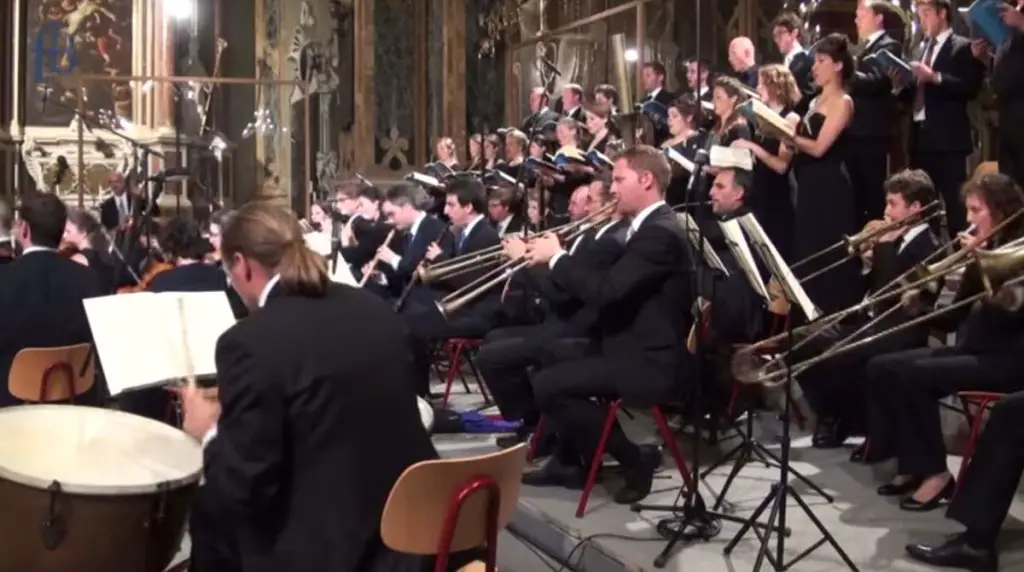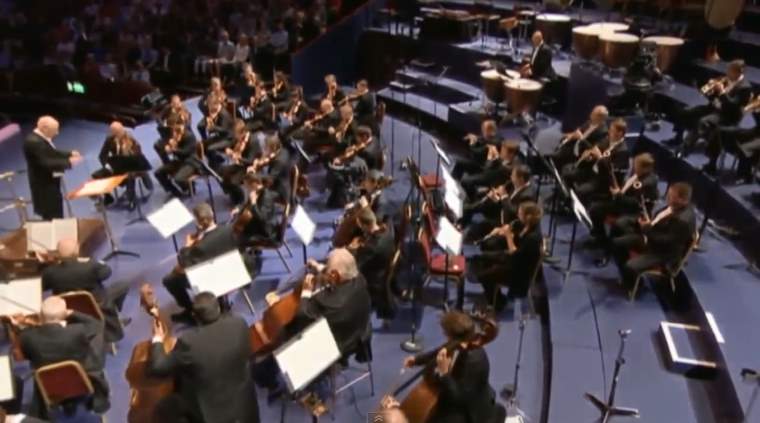Conducted by Phillip A. Swan, the Lawrence Symphony Orchestra, Viking Chorale, and Cantala Concert Choir perform The Creation (German: Die Schöpfung), an oratorio written between 1797 and 1798 by Joseph Haydn (H. 21/2). It is considered by many to be the Austrian composer’s masterpiece. Soloists: Emily Birsan (soprano): Gabriel, Eva; Luke Honeck (tenor): Uriel; Evan Bravos (bass): Raphael, Adam. This performance was recorded on April 29, 2016.
The Creation, oratorio by Joseph Haydn
The Creation, an oratorio composed by Joseph Haydn between 1796 and 1798, is widely regarded as one of his most significant works and a cornerstone of choral music. Inspired by the biblical accounts of the world’s creation as described in the Book of Genesis, this monumental piece showcases Haydn’s mastery of orchestration and vocal composition. The oratorio features a rich tapestry of musical forms, including recitatives, arias, and choruses, effectively conveying the majesty and grandeur of creation.
Haydn’s inspiration to compose a large oratorio stemmed from his visits to England during the years 1791-1792 and 1794-1795. During this time, he attended performances of George Frideric Handel’s oratorios, conducted by large ensembles, alongside his close friend, English music historian Charles Burney. These experiences likely motivated Haydn to create a work of similar magnitude, utilizing the musical language of the mature classical style. Among the Handel compositions he encountered was Israel in Egypt, which features various instances of tone painting, an element that Haydn would later incorporate extensively in his own oratorio, The Creation.
The work is structured in two parts, depicting the world’s creation and humanity’s subsequent creation. Haydn employs a vivid orchestral palette, using strings, woodwinds, brass, and percussion to paint a sonic picture of the cosmos coming to life. The opening “Representation of Chaos” is particularly notable for its innovative use of dissonance and rhythmic complexity, mirroring the tumult before creation. As the narrative unfolds, the music transitions to moments of tranquility and harmony, symbolizing the arrival of light, land, and life.
The text, primarily in English, was based on the work of the English poet John Milton’s (9 December 1608 – 8 November 1674) Paradise Lost and the biblical Genesis, showcasing Haydn’s deep engagement with themes of faith and nature. The oratorio was first performed in Vienna in 1798 and quickly gained popularity, becoming a staple in the choral repertoire. The Creation not only reflects Haydn’s profound musical genius but also his ability to communicate the awe of creation, making it a timeless piece celebrated by audiences worldwide.
The oratorio is scored for three vocal soloists (soprano, tenor, and bass; there is also an incidental solo for alto in the finale), a four-part chorus (soprano, alto, tenor, bass), and a large Classical orchestra.
The Creation Structure
Joseph Haydn’s oratorio is structured in three parts, the first dealing with the Creation of the universe and the plants, the second with the Creation of the animals, and of man and woman, and the third with Adam and Eve in Paradise, showing an idealized love in harmony with the “new world”.
In Parts I and II, the three soloists embody angels who narrate and comment on the six days of creation. The roles are assigned as follows: Gabriel (soprano), Uriel (tenor), and Raphael (bass). In Part III, the characters of Adam and Eve, the first man and woman from the Bible, are introduced during their time in the Garden of Eden before the Fall. Typically, the role of Adam, a bass, is sung by the same performer who portrays Raphael, while the soprano role of Eve is usually taken by the same singer as Gabriel. Although this casting practice is favored by Haydn, some conductors opt to assign each of the five roles to different soloists.
The choral sections of the oratorio feature a series of monumental choruses, many of which celebrate the conclusion of each day of creation. The orchestra plays a vital role as well, particularly during episodes of tone painting, such as the emergence of the Sun, the creation of various animals, and especially in the overture, which famously depicts the chaos that existed before creation.
First Part
- Introduction: Chaos: This opening sets the stage for the oratorio, representing the disordered state of the universe before creation, using dissonance and tumultuous music to evoke chaos.
- Accompanied Recitative “In the Beginning”: The tenor narrates the biblical beginning of creation, introducing the concept of God’s creation of the world, and establishing a solemn and reflective tone.
- Tenor Air & Chorus “Now Vanish”: The tenor expresses a desire for chaos to disappear, followed by a chorus that reinforces this theme of transformation and the emergence of order from chaos.
- Bass Recitative “And God made”: The bass recounts God’s actions in creating light, emphasizing the divine authority and power of the Creator.
- Soprano Solo & Chorus “The marv’lous work”: A soprano solo highlights the beauty of creation, with the chorus joining in to celebrate the marvelous works of God, showcasing the joy of creation.
- Bass Recitative “And God said”: The bass continues to narrate God’s commands, setting the stage for the unfolding acts of creation.
- Bass Air “Rolling in Foaming Billows”: This aria vividly depicts the waters being created, with the bass conveying a sense of motion and grandeur as the sea comes into existence.
- Soprano Recitative “And God said”: The soprano reinforces God’s commands regarding the earth and vegetation, maintaining the narrative continuity.
- Soprano Air “With Verdure Clad”: The soprano praises the lush greenery of the earth, using vibrant imagery to celebrate nature’s beauty and abundance.
- Tenor Recitative “And the Heavenly Folks”: The tenor describes the creation of celestial bodies, enhancing the cosmic theme of the oratorio.
- Chorus “Awake”: This lively chorus calls upon all of creation to awaken, embodying the joy and vibrancy of the newly formed world.
- Tenor Recitative “And God said”: The tenor continues to narrate God’s creative words, emphasizing the power and authority of divine speech.
- Tenor Recitative “In Splendor Bright”: The tenor reflects on the brilliance of creation, foreshadowing the celebratory nature of the subsequent sections.
- Chorus & Trio “The Heavens are Telling”: This grand finale of the first part celebrates the glory of God as revealed in the heavens, showcasing Haydn’s mastery of choral writing.
Second Part
- Soprano Accompanied Recitative “And God said”: The soprano introduces the theme of the creation of animals, continuing the narrative with a sense of anticipation.
- Soprano Air “On Mighty Pens”: In this aria, the soprano praises the beauty and variety of God’s creations, emphasizing the wonder of the natural world.
- Bass Accompanied Recitative “And God created”: The bass recounts the creation of various animals, providing a detailed depiction of God’s work.
- Trio “Most Beautiful”: This trio celebrates the beauty of the created animals, showcasing the joy and harmony of nature.
- Chorus & Trio “The Lord is Great”: The chorus and trio affirm the greatness of God, praising the wonders of creation with a powerful musical statement.
- Bass Accompanied Recitative “And God said”: The bass continues the narrative, introducing the creation of humanity.
- Bass Air “Now Heav’n”: In this aria, the bass reflects on the creation of heaven and earth, highlighting the divine act of bringing humanity into existence.
- Tenor Recitative “And God created Man”: The tenor narrates the moment of humanity’s creation, emphasizing the special role humans play in God’s plan.
- Tenor Air “In Native Worth”: This aria expresses the dignity and worth of humanity, celebrating the unique qualities bestowed upon humans by their Creator.
- Bass Recitative “And God Saw”: The bass describes God’s approval of creation, culminating in a sense of fulfillment.
- Chorus & Trio “Achieved is the Glorious Work”: This triumphant finale of the second part celebrates the completion of creation, showcasing Haydn’s grand choral writing and the joy of divine achievement.
Third Part
- Tenor Accompanied Recitative “In rosy mantle”: The tenor introduces the theme of the beauty and harmony of nature, describing the ideal state of creation as a vibrant and flourishing environment.
- Duet & Chorus “By thee with bliss”: This duet celebrates the joy of existence, with both soloists and chorus expressing gratitude and reverence toward the Creator for the wonders of life.
- Bass & Soprano Recitative “Our duty”: In this section, the bass and soprano discuss the responsibilities of humanity to care for the world, emphasizing a moral and ethical dimension to the creation narrative.
- Duet “Graceful consort!”: This duet highlights the harmonious relationship between Adam and Eve, portraying their unity and the beauty of companionship in the newly created world.
- Tenor Recitative “O Happy Pair”: The tenor reflects on the blissful state of Adam and Eve, celebrating their innocence and joy in paradise.
- Chorus “Sing the Lord”: The oratorio concludes with a triumphant chorus, encouraging all of creation to sing praises to the Lord. This finale encapsulates the themes of joy, harmony, and the celebration of divine creation.
Sources
- The Creation structure on Wikipedia
- “The Creation, oratorio by Joseph Haydn” on the Encyclopedia Britannica website
- The Creation (Haydn) on Wikipedia

